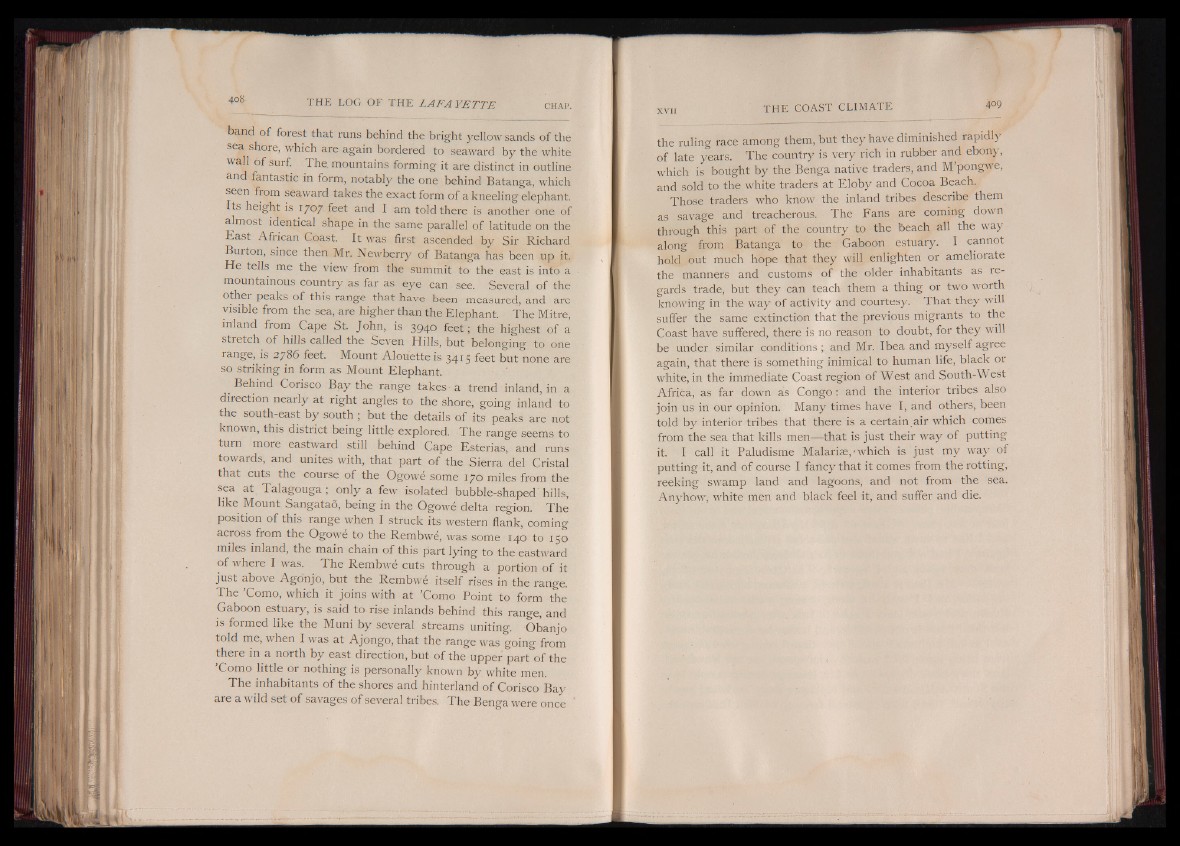
band of forest that runs behind the bright yellow sands of the
sea shore, which are again bordered to seaward by the white
wall of surf. The. mountains forming it are distinct in outline
and fantastic in form, notably the one behind Batanga, which
seen from seaward takes the exact form of a kneeling elephant.
Its height is 1707 feet and I am told there is another one of
almost identical shape in the same parallel of latitude on the
East African Coast. It was first ascended by Sir Richard
Burton, since then Mr. Newberry of Batanga has been up it.
He tells me the view from the summit to the east is into a
mountainous country as far as eye can see. Several of the
other peaks of this range that have been measured, and are
visible from the sea, are higher than the Elephant. The Mitre,
inland from Cape St. John, is 3940 feet; the highest of a
stretch of hills called the Seven Hills, but belonging to one
range, is 2786 feet. Mount Alouetteis 34 ^ 5 feet but none are
so striking in form as Mount Elephant.
Behind Corisco Bay the range takes a trend inland, in a
direction nearly at right angles to the shore, going inland to
the south-east by south; but the details of its peaks are not
known, this district being little explored. The range seems to
turn more eastward still behind Cape Esterias, and runs
towards, and unites with, that part of the Sierra del Cristal
that cuts the course of the Ogowe some 170 miles from the
sea at Talagouga; only a few isolated bubble-shaped hills,
like Mount Sangatao, being in the Ogowfi delta region. The
position of this range when I struck its western flank, coming
across from the Ogowe to the Rembwe, was some 140 to 150
miles inland, the main chain of this part lying to the eastward
of where I was. The Rembwe cuts through a portion of it
just above Ago'njo, but the Rembwe itself rises in the range.
The ’Como, which it joins with at ’Como Point to form the
Gaboon estuary, is said to rise inlands behind this range, and
is formed like the Muni by several streams uniting. Obanjo
told me, when I was at Ajongo, that the range was going from
there in a north by east direction, but of the upper part of the
’Como little or nothing is personally known by white men.
The inhabitants of the shores and hinterland of Corisco Bay
are a wild set of savages of several tribes. The Benga were once
the ruling race among them, but they have diminished rapidly
of late years. The country is very rich in rubber and ebony,
which is bought by the Benga native traders, and M’pongwe,
and sold to the white traders at Eloby and Cocoa Beach.
Those traders who know the inland tribes describe them
as savage and treacherous. The Fans are coming down
through this part of the country to the beach all the way
along from Batanga to the Gaboon estuary. I cannot
hold out much hope that they will enlighten or ameliorate
the planners and customs of the older inhabitants as regards
trade, but they can teach them a thing or two worth
knowing in the way of activity and courtesy. That they will
suffer the same extinction that the previous migrants to the
Coast have suffered, there is no reason to doubt, for they will
be under similar conditions ; and Mr. Ibea and myself agree
again, that there is something inimical to human life, black 01
white, in the immediate Coast region of West and South-West
Africa, as far down as Congo: and the interior tribes also
join us in our opinion. Many times have I, and others, been
told by interior tribes that there is a certain air which comes
from the sea that kills men— that is just their way of putting
it. I call it Paludisme Malariae,-which is just my way of
putting it, and of course I fancy that it comes from the rotting,
reeking swamp land and lagoons, and not from the sea.
Anyhow, white men and black feel it, and suffer and die.